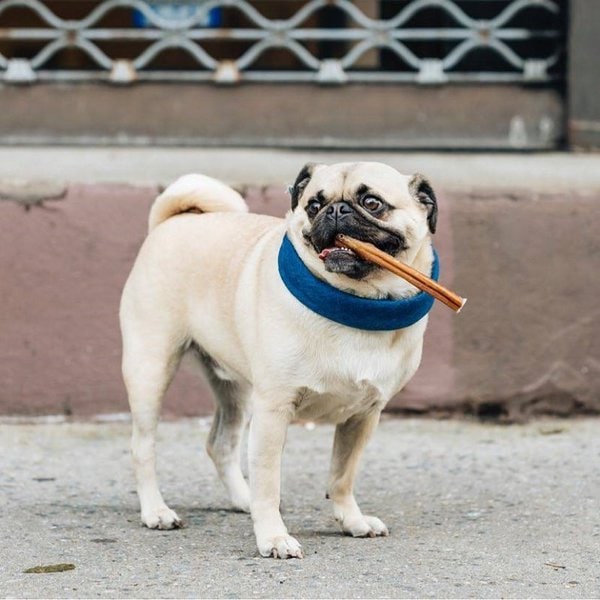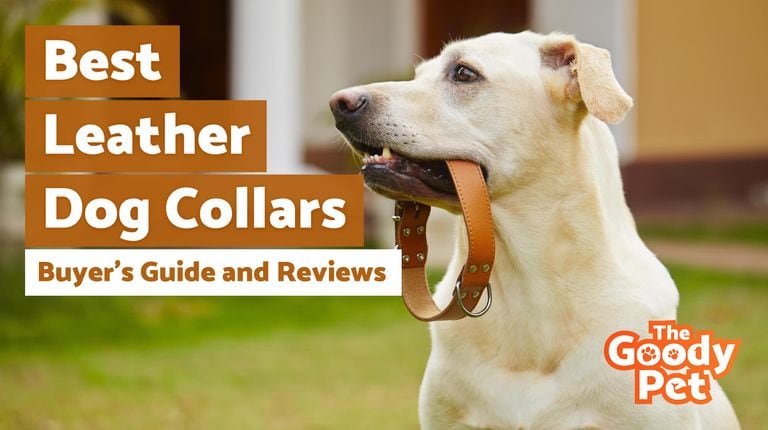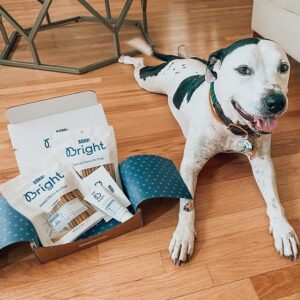The best leather dog collar is Soft Touch Collars Luxury Real Leather Padded Dog Collar.
In most places, buying a dog collar is a legal requirement for all dog owners in preparation for trips out with your pet. Plus, it’s a valuable place to write your dog’s particulars (name and vet details) which will make it easier to find his owner should he ever get lost.
Leather is the ideal material for your dog collar. Besides being extremely durable, leather dog collars are easy to clean and maintain.
Here are our picks of the top 11 best leather dog collars on the market, with pros and cons for each so that you can make an informed choice.
#1 Soft Touch Collars Luxury Real Leather Padded Dog Collar
There are many reasons why we chose the Soft Touch Luxury dog collar as the best leather dog collar on our list.
First of all, this leather collar made from padded leather which is as comfortable and soft as it is durable. Unlike dog collars that are made from cheap materials, this one won’t develop an odor over time and will remain dry as well. It will retain its smell of genuine leather because it’s made from natural sheepskin leather that’s fully tanned. Your dog certainly won’t develop any rashes or discomforts when wearing this leather dog collar.
Soft Touch spared no expense while designing this dog collar, as evidenced by its robust hardware. Take the D-ring for example, which is made from rust-free and non-corrosive metal that can handle water without getting damaged.
All in all, you and your dog will enjoy this leather dog collar for many years to come thanks to its exceptional blend of durable and aesthetically-pleasing design.
The soft sheepskin leather is comfortable enough to be worn for long periods of time without irritating your dog’s neck.
Pros
- This Soft Touch dog collar product is padded with soft sheepskin leather to ensure that the collar is comfortable for pooches to wear and also to prevent skin irritation.
- The mini brass ring installed on this canine collar provides a convenient means for customers to attach their pooch’s name tags for easy identification.
- The D-ring that is located on the Soft Touch collar ensures that customers can easily attach leashes to provide greater control when taking their canine buddies on walks.
- Soft Touch’s leather padded collar comes in a variety of sizes and color combinations to ensure compatibility with different dog neck sizes and cater to individual customer preferences.
- This canine collar product comes with a generous lifetime warranty offer from the Soft Touch brand, in the event that the collar ever fails due to poor craftsmanship.
Cons
- Several customers have commented that the color of this padded dog collar tends to rub off and fade easily.
- There are inconsistencies in product sizing, as several customers have reportedly received Soft Touch collars that are either too wide or too long for their pooch’s necks, despite ordering within their dogs’ size categories.
This product emerges as the top pick because it is hand-made using 100% non-dyed leather material guaranteed to last for decades, and it is is lined with soft sheepskin for a comfortable and nonirritating fit on a dog’s neck.
#2 Mighty Paw Leather Dog Collar
Coming in as second on the list of the best leather dog collars. this comfortable padded leather collar from Mighty Paw is designed for the active pup that regularly hikes and runs with its owner.
It’s lightweight, nicely designed, and durable. This leather dog collar can handle the elements and won’t tear easily, thanks to its sturdy natural cowhide construction, which is accented by premium quality alloy hardware.
Your dog can play and run freely without restrictions, as this leather dog collar is made to fit comfortably. Instead of bulky leather, it has a very soft texture that’s lightweight and completely non-abrasive. It’s very different from bulky dog collars that you may be used to, which can be quite heavy for most pups.
This leather dog collar is built tough and comes in five adjustable sizes to choose from so that your pup can wear it for years to come.
This cowhide collar is made from the finest leather and has a modern distressed design with an embossed logo. It’s not only stylish but durable and long-lasting too.
Pros
- The natural rawhide material and durable alloy metal used to produce Mighty Paw’s leather dog collar are strong enough to resist damage from the activities of playful dogs.
- The soft and pliable leather material used to manufacture this canine collar product provides comfort and ensures that a pooch can continue wearing the collar for a considerable period without getting irritated skin.
- The Mighty Paw collar is lightweight and can be worn by a dog without the pooch getting weighed down.
- The combination of distressed leather and shiny silver hardware gives the Mighty Paw collar a stylish and aesthetically pleasing look.
- The width of this leather canine collar can be adjusted in five different settings to provide a convenient fit for various dog neck sizes and to accommodate changes in a pooch’s neck size as it grows.
Cons
- This leather dog collar comes with just a single metal ring for the leash and identification tag attachment.
- Multiple customers have commented that the Mighty Paw leather collar comes with a strong chemical smell, which raises questions about the safety of the product for use with dogs.
#3 Beirui Genuine Personalized Leather Dog Collars
It can be hard to find a good quality leather collar for large breed dogs which is why Beirui has designed this personalized leather dog collar. It’s made from soft and lightweight leather that’s durable enough to withstand the daily wear and tear of an active and large-sized dog.
It has a modern yet minimalist look that’s characterized by accents like the chromed D-ring and an alloy buckle. This is in addition to the handy nameplate ID tags which you can use to inscribe your dog’s name and details.
It comes in different widths and sizes for dogs of all ages. Plus, it comes with a 100% money-back guarantee from Beirui that covers quality defects.
The simple, straightforward design of this sturdy dog collar from Beirui is ideal for dog owners with active pups. It offers premium quality construction and a money-back guarantee to back it.
Pros
- Beirui’s leather dog collars are produced with tough and durable natural cowhide material to ensure that they can last for a considerable period, even with consistent use.
- Customers have the option to personalize their Beirui leather collars with details such as their dog’s name, phone number, and address, thereby providing an effective means of identification in the event that a pooch ever gets lost.
- The inclusion of a D-ring on the Beirui leather collar provides an outlet for customers to attach leashes to maintain control over their canine buddies during outdoor activities.
- The Beirui leather collar is typically designed with six eyelets to provide a way for customers to make the necessary adjustments to ensure that their dogs remain comfortable while wearing the collar.
- This leather collar for dogs from the Beirui brand comes with a 100% money-back guarantee that covers defects that are due to manufacturer error.
Cons
- Several customers have commented that the engravings on the nameplates of their Beirui leather collars faded and became worn off only after a few months of use.
- Additionally, there have been multiple reports of this leather collar’s nameplates easily bending and getting damaged.
#4 Warner Brand Cumberland Leather Dog Collar
Apart from attaching to your dog’s leash, a collar makes it easier for dog owners to provide identification of their furry companions. This dog leather collar from Warner Brand Cumberland features a stylishly designed ID tag in durable brass metal on which you can emboss your dog’s details.
This is a genuine leather collar proudly handmade in the US. Plus, it’s available in three different colors, including rich brown, tan and black, with a sturdy D-ring that you can use to attach your leash whenever you go on hikes or walks with your dog.
This leather dog collar from Warner Brand Cumberland is made from top-notch leather and features an engraved ID tag. It also happens to be reasonably priced and yet it’s one of the most comprehensive options on this list.
Pros
- Warner Brand’s leather dog collar typically becomes softer and more comfortable for a pooch to wear with continued usage.
- The nickel-plated D-ring on the Cumberland dog collar provides a means for customers to connect leashes and maintain control over their canine buddies during outdoor activities.
- Customers can choose to personalize the Cumberland leather collar with details such as their pooch’s name, home address, and phone number to contact, in case the pooch in question goes missing.
- The lightweight metal plate of the Warner Brand leather collar conforms well to the shape of a pooch’s neck.
- The heavy-duty leather material used to produce this canine collar is durable and can withstand damage from the excesses of rough dog play.
Cons
- Several customers have expressed displeasure at the fact that the Cumberland collar’s name tag and metal hardware have contrasting colors.
- Some customers have also reported that their orders came with spelling errors, different from what was requested for, from the Warner Sporting brand.
#5 CollarDirect Leather Dog Collar
Thanks to CollarDirect’s expert craftsmanship, this leather collar is one of the best that we’ve seen on the market. It’s lightweight yet durable enough for your dog to wear comfortably regardless of the situation. It’s suitable for small and large dogs alike and it’s made from genuine full-grain leather.
This leather dog collar comes in several different colors to suit all types of dog personalities. It features solid brass hardware that’s suitable for dogs with skin sensitivities. You can even use it on pups that suffer from conditions like psoriasis.
The soft interior padding won’t irritate the coat and you’ll be glad to know that this is one of those long-lasting collars that you can look forward to using for the rest of your dog’s life.
This is one of the most well-made leather dog collars that we’ve seen. The attention to detail and the stitching is simply out of this world. It’s also tough wearing and long-lasting as well.
Pros
- CollarDirect’s handmade leather collars are available in a variety of sizes, ranging from small to extra-large, to ensure convenient fits for different dog neck widths.
- The padded interior of this dog collar product is made with specially treated soft leather material that is comfortable for pooches and can be safely worn without causing skin irritation.
- The full-grain genuine leather material used to craft the CollarDirect collars is durable and can withstand damage due to the wear and tear that comes with consistent use.
- The CollarDirect leather collar comes with multiple eyelets that enables customers to make adjustments to the width of the collar in order to provide a convenient fit for their canine buddies.
- The D-ring included on this CollarDirect product provides a way for customers to attach a leash for talking and controlling their canine buddies on walks.
Cons
- The CollarDirect collar has sizing issues, as there have been several reported instances of customers receiving products that were either too big or too small for their canine buddies, despite carrying out neck measurements as instructed.
- Some customers have also commented that this collar’s D-ring was too small for them to attach a leash.
#6 Ellie Dog Wear Full Grain Leather Dog Collar with Saddle
With quality and durability in mind, Ellie Dog Wear created this exceptional full grain leather dog collar. It’s comfortable for your dog to wear and durable enough so that you won’t have to buy another one for many years to come.
You’ll find that it’s soft to the touch when you handle it and it’s coated with saddle leather wax for added strength. This is what makes it better than full-grain leather collars.
In terms of design, this heavy duty leather collar has a distinct vintage look with rustic detailing that gets better with time. The Ellie Dog luxury collar is perfect for small pups but it comes in different sizes for older dogs too.
Ellie Dog is a trusted manufacturer of dog collars, and for a good reason. Their collars are made from premium quality leather that’s coated with saddle leather wax to improve durability.
Pros
- The Ellie dog collar features a wax coating that enhances the leather fibers within the collar and, subsequently, strengthens and increases the product’s ability to withstand damage.
- The brassware of this full-grain leather dog collar is made of rust-proof material and also coated with a clear finish to prevent corrosive damage.
- The lightweight nature of Ellie Dog’s leather collar ensures that it can be comfortably used on small-sized pooches without weighing down the dogs in question.
- Ellie’s leather dog collar product comes with a separate D-ring for easy and convenient leash attachment when taking Fido on a walk.
- This leather dog collar product from the Ellie brand is manufactured without using artificial dyes, thereby ensuring that the collar is generally safe for a pooch to wear.
Cons
- Several customers have reportedly received Ellie leather dog collars that arrived dry and cracked, and were subsequently easy for their canine buddies to damage.
- The metal ring on this leather collar that is intended for leash attachment tends to rip off easily, thereby providing an avenue for pooches to escape.
#7 Chede Luxury Real Leather Dog Collar
If you’re looking for a combination of style, durability, and luxury, the Chede dog collar is the ultimate gift. It’s handmade from 100% genuine leather and it features edges that won’t irritate the skin. It’s smooth to the touch and fully adjustable so your dog can continue to wear it as he gets older.
It’s perfect for medium to large-sized dogs, while the lined interior is padded for maximum flexibility and comfort. Your dog won’t even notice they’re wearing this leather collar and will continue to run around and have fun with no restrictions.
The Chede Luxury dog collar is made for pups on the move. It features 100% genuine leather with very impressive metal detailing and stitching. Plus, all you need to clean it up is a soft damp cloth and perhaps a mild leather cleaner.
Pros
- The metal detailing and real leather finishing on Chede’s luxury collar for dogs are aesthetically pleasing and enhance a pooch’s overall look.
- The insides of this real leather collar is padded with soft material to protect a pooch’s neck region from skin irritation that typically develops as a result of the collar rubbing against the neck.
- The metal buckle of the Clyde collar provides a quick and convenient way for customers to wear and remove the product from their dogs’ necks.
- The texture of the Chede real leather dog collar is such that it can be cleaned with a soft damp cloth and any suitable leather cleaner to provide customers with convenient maintenance.
- Customers can adjust the widths of the various Chede leather dog collar variants from sizes ranging between 8.9” to 19.2” to provide convenient fits for different dog neck sizes.
Cons
- The red colored version of Chede’s leather color tends to color-bleed, especially when exposed to water, and subsequently stain a pooch’s fur.
- There are multiple reports about this collar’s metal clip not staying clipped on, especially when the collar is being used with a leash, thereby resulting in situations where dogs can potentially escape.
#8 Perri’s Padded Leather Dog Collars
This Amish-made collar from Perri’s is a budget-friendly yet good quality option that can withstand the elements. This means you can take your dog for walks no matter the weather, knowing that this dog leather collar won’t get damaged. This is not one of those “here today, gone tomorrow” value buys.
It’s handmade in the US from 100% fade-proof and durable lambskin leather. It’s available in a number of different colors to suit different preferences, with our favorite being the red and white theme. It’s soft to the touch and comfortable to wear because it doesn’t irritate the skin.
You’ll also be glad to know that this dog collar is easy to clean, and its solid brass fittings won’t get damaged over time.
Perri’s Padded Leather Dog Collar has certainly earned its spot on this list with a unique and handcrafted design. It’s available in different colors, at a reasonable price and it’s super comfortable.
Pros
- Perri’s padded leather collars are available in various size options ranging extra small to extra-large to ensure compatibility with multiple dog neck widths.
- The soft, lambskin padding of Perri’s leather collar is gentle on a pooch’s skin and ensures that the product can be worn without bruising a dog’s neck region.
- The padded leather dog collars produced by Perri’s are handmade in the United States, with top-notch leather material to guarantee the durability and quality of the collar products.
- Multiple customers have commended the workmanship on display with Perri’s leather dog collars, with special praise reserved for the quality of the product’s stitching and dog-friendly design.
- The holes punched within this leather dog collar are generally uniform, oblong and sized large enough for customers to conveniently insert the buckle post.
Cons
- The absence of a retaining loop to hold the unused portion of the collar’s strap can be inconvenient for both dogs and humans.
- The buckle of Perri’s collar is, sometimes, not firmly sewn into the leather, thereby resulting in this buckle uncomfortably wiggling from side to side.
#9 Logical Leather Padded Dog Collar
This padded leather collar from Logical is well, a “logical” option for any dog owner. It’s made from comfortable leather with multiple layers for extra padding. This dog collar makes it easy to restrain your dog on outings without chocking it.
It’s made from full-grain leather that won’t fray or rip like traditional dog collars, and at 26 inches long, you can rest assured that it will fit most dogs no matter the size.
This dog leash also features sturdy loops that will give you a peace of mind after you’ve attached the leashes and tags, while the premium quality metal clasp and leash ring make for nice finishing touches. Just be sure to measure your dog beforehand to make sure that this dog collar is suitable, otherwise, it’s a good quality leather collar option and you can’t beat the price.
This high-quality leather dog collar is handmade in the US of A, and it features a stylish design that any pet owner can be proud of. It’s perfect for taking your dog on walks and it’s suitable for training or just relaxing as well. It’s very comfortable.
Pros
- The full-grain, genuine leather material used to produce the Logical padded dog collar offers durability and ensures that the product can last for a considerable period, when properly used.
- The heavy-duty metal clasp and leash ring of this dog collar product is built and designed to withstand damage from excessive pulling by a pooch.
- The insides of the Logical canine collar are made with soft, padded split leather lining to provide additional comfort for the pooch wearing the collar.
- This leather padded dog collar product from the Logical brand is backed by a lifetime guarantee that provides replacements for defective products and refunds in cases where the collar doesn’t meet a customer’s expectations.
- The leather material of the Logical padded collar is easy to clean with a soft damp cloth and it also doesn’t retain dog hair like nylon collars.
Cons
- The collar leash ring is placed too close to the buckle and this results in both of them occasionally clashing, which is inconvenient for customers.
- The sizes of the Logical leather collar are inconsistent, with several customers reportedly receiving collars that were either too small or too large for their pooches to wear without needing to make adjustments.
#10 Coastal Pet Circle T Nickel Buckle Latigo Dog Collar
Coastal Pet Circle has created a formidable leather collar with an adjustable size that guarantees a comfortable fit regardless of dog breed or size. This is a handcrafted model with durable materials like Latigo leather which is known for its non-irritating quality.
Thanks to its unique construction, this leather collar is perfect for dogs with long hair and sensitive coats as well. It’s lightweight, easy to clean, and is suitable for use on all occasions.
We really like the strength and durability of this leather dog collar. It’s adjustable and comes highly recommended for longhaired dogs. Plus, the nickel-plated snap is a nice touch.
Pros
- The rounded design of Coastal Pet’s dog collar is comfortable for pooches to wear and is intended to prevent the rubbing and irritation of a dog’s neck region due to prolonged wearing of the collar.
- The rolled design of the Coastal Pet canine collar is ideal for pooches with long hair, as it prevents the matting of a dog’s hair and the formation of collar lines that are typical with flat collar products.
- Coastal Pet’s Latigo dog collar tends to maintain its rich color and not fade, even with consistent usage.
- This leather canine collar is lightweight and can be comfortably worn by a pooch for extended periods.
- The Coastal Pet canine collar is handcrafted and produced with durable leather material that lasts for a considerable period of daily use.
Cons
- Several customers have been confused by the sizing descriptions provided by the Coastal brand and ended up purchasing the wrong collar size as a result.
- Multiple customers have commented that the leather material used to produce the Coastal Pet collar is too stiff and usually ends up being uncomfortable for their pooches to wear after some time.
#11 Viosi Leather Padded Dog Collar
The Viosi padded leather collar is the perfect choice for cute pooches. It’s very soft and lightweight, with comfortable padding for non-restrictive long wear. It doesn’t stretch very much but we’re sure that most dog owners will appreciate the tanned buffalo hide construction.
This is an excellent design with an inner leather layer and extra cushioning for added support. This prevents the neck from being inflamed and can easily be worn all day without a problem.
The stitching is done with super durable thread that’s made to ensure that the leather collar doesn’t fall apart no matter how much you and your dog put it through. Plus, it won’t shrink over time because it has a genuine leather interior while the solid brass handle will keep your pup secure whenever you go for walks.
Take your dog on a comfortable walk knowing the leash is secure thanks to this affordable yet high-quality leather collar. It comes with notable features that include detailed hand stitching, a solid brass buckle, and an eco-friendly design that makes it suitable for use in different climates.
Pros
- Viosi’s padded dog collar comes fitted with two metal brass rings that can be used to attach dog tags for convenient identification and leashes to provide control over dogs during walks.
- The aesthetically pleasing two-toned design of the Viosi leather collar looks good and elevates the appearance of most dogs.
- The interior leather material of the Viosi collar is effective at protecting a pooch’s skin from the irritation that typically accompanies wearing a collar for a considerable period.
- The Viosi canine collar features several belt eyelets, which ensures that the product can continue to be used irrespective of changes in a pooch’s neck width.
Cons
- The thick leather material and short stem of this dog collar product usually result in customers finding it difficult to remove the collar from their pooches’ necks.
- Some customers have reported that this leather padded collar comes with an unpleasant chemical smell, which refuses to dissipate even after airing the product for a few days.
Leather Dog Collars Buyer’s Guide
As with any purchase, it’s important that you make an informed choice based on proper consideration. Here are some of the most important things to know when looking for the best leather dog collar.
Size & Design
You want your dog to feel comfortable when wearing its collar and that’s why fit is important. Thankfully, most collars are either adjustable or available in different sizes. It’s always a good idea to measure your dog’s neck beforehand to make sure that you get the correct size.
Durability
Leather is one of the most durable materials known to man which is why leather collars are unmatched in quality. But, there are different types of leather, some cheaper than others. You’ll do well to opt for a good quality option even if you need to pay more for it. A collar should also come with a durable metal D-ring that won’t break when you pull on your dog’s leash during walks.
Comfort
You also want a collar that’s comfortable for your dog to wear, one that won’t choke or irritate the coat. Padded collars with a soft leather interior are your best bet in this regard and are the first preference for most dogs.
Style
Style is a personal matter of course, but it’s safe to say that there are plenty of stylish options out there. Some leather collars are designed according to a rustic and vintage style, while others have a more modern and minimalist look.
Most dog collars come in a brown or tan color, but there are other colors out there for those who would prefer a more unique option. Some designs are even specially made to suit a specific outdoor activity – such as hands-free dog leashes. But, the most important thing is to look for durability first and style. Secondly, be sure to choose a color that suits your dog’s personality and temperament.
Keep in mind that it will take a few days to break in a leather collar and your dog might fidget during that time but after that, it’ll become completely comfortable.
To maintain the leather, it’s very important that you clean it whenever necessary and rinse it after every walk. Leather moisturizers are also a good idea if you want to preserve the quality of your dog’s leather collar.
How Tight Should A Dog Collar Be?
Getting a collar for your dog is essential, whether you own a puppy or an adult dog. The collar will help you keep your dog safe and protected as you go for a walk outdoors. You can also attach your contact info and other important details on the collar of your dog. That way, if your dog gets lost accidentally, whoever will find your dog will know whom to call.
These days, you’ll find a wide variety of dog collars in the market. They are available in different sizes, styles, and are made from different materials. But it’s extremely important that you exercise caution when attaching the collar to your pet’s neck since it tends to go around its neck and might lead to choking.
So how tight should the collar be? To address this question, read on as we talk about how you should attach your dog’s collar in a way that your pooch will feel safe and comfortable.
Related: Best Chew-Proof Dog Collar
How Much Space Should There Be Between The Collar And Your Dog’s Neck?
Considering the things discussed above, it’s vital that pet owners are aware of the recommended space that should be between the dog’s collar and its neck. If you see a small space in between the collar and your pet’s neck, then just leave it there. Otherwise, you’ll run the risk of it becoming too loose and allowing your pet to be able to slip easily.
Try to slip your two fingers in between the neck and the leather dog collar, and if they fit snugly, then that should be right. Remember that your two fingers shouldn’t feel tight when you push them in.
If you feel that they are too tight, then loosen the collar a bit. But there shouldn’t be plenty of space around your fingers, or it will be too loose, and your pet will easily slip through. This method is what dog experts call the two-finger rule.
What About The Width Of The Dog Collar?
You should also consider the collar’s width when choosing one for your pet. Small dogs like pugs would feel more comfortable with a thinner collar, but large dogs must have thick and wide collars to accommodate their large neck.
If you’re going to use a thin collar on your large dog, this might make it feel uncomfortable while small dogs find thick colors annoying and uncomfortable.
If possible, bring your dog with you as you shop for a collar from a pet store. Get your pet to try the collar before deciding to buy it. The store attendants should be able to offer the best advice when it comes to the right collar for your pet.
Related: Best Dog Collar For Pulling

Dog Throat Injury From Collar: Here’s What You Need To Know
One of the most important accessories that dogs wear every single day of their lives is the dog collar. So when it comes to buying a collar for your dog, you should only go for the best. The leather dog collar is, without a doubt, one of the best types of dog collars out there. It’s very durable and is guaranteed to last long despite daily use.
But before you get a leather collar for your pooch, you need to first educate yourself about the dangers of a dog throat injury. Here’s everything you need to know about this issue.
What Happens If You Don’t Fit the Collar Properly?
An ill-fitting collar will cause your dog’s neck to chafe and might eventually lead to long-lasting discomfort and injury to your dog’s throat. It’s truly unfortunate that some pet owners are not aware of this issue and that’s usually because the leather dog collar conceals the abrasion on the skin. Also, dogs are not able to tell their master what it is that’s causing the discomfort.
Usually, leather dog collars that are too tight on your dog could irritate its neck and could lead to chaffing. Some of the most common symptoms of a chaffed neck are hair loss, redness, and skinned appearance. The chaffing will usually come in the form of a string or line that mimics the shape of the collar.
Chaffing shouldn’t be mistaken for dermatitis or other skin conditions, which usually come with inflammation and itchiness on the wrists, eyes, limbs, ankles, toes, and groin.
What to Do If Your Dog’s Neck Gets Injured?
Here are some of the most practical solutions when it comes to addressing your dog’s throat injury resulting from the use of a dog leather collar.
Loosen Up The Collar
Understandably, if the collar is too tight for your dog, then this will most likely cause injury. When attaching the dog leather collar to your dog’s neck, use the two-finger test to ensure that the collar is not too tight. Simply insert your two fingers on the collar and if it’s not too loose or too tight, then leave it at that.
Remove Collars That Cause Pain
Don’t use any collar that could trigger pain, such as the prong or shock collar. Instead, opt for other types of collars such as the Martingale collar that’s made of leather. This is usually safer and more comfortable for your dog and prevents any throat injury.
Train Your Dog How To Walk When On A Collar
If you noticed that your dog tends to pull and strain as it walks with the collar on, then you should train your dog the right way to walk so it will not end up injuring its throat. Teach your dog to walk calmly, and when it does, encourage it by giving it treats.
Consider The Moisture
Usually, a wet or moist collar could trigger the chaffing of your dog’s neck. Therefore, make sure you take off the dog leather collar when it becomes wet. Wipe the collar dry before you put it back on your dog’s neck.
Treat Chafing Carefully
Minor injury on the throat of your dog resulting from the use of a dog leather collar can be treated with salve, which is the same product used in treating nappy rashes. You can also apply coconut oil but keep the neck of your pooch free from the collar while you leave the treatment on.

Dog Collar Materials: What Are They Commonly Made Out Of?
Dog collars are available in a wide range of options. They come in different colors, sizes, and designs. This variety of choices can be overwhelming for most pet owners. Knowing what to choose and what to leave behind requires a lot of research, and it may take more time than you’d expect.
But once you have decided the type of dog collar you want for your pet, the next step would be to pick the right material. A few different materials have been used to make dog collars over the years. Each of the materials has its advantages and disadvantages.
Let’s dive into our list of some of the common dog collar materials, their advantages, as well as their drawbacks.
Material #1: Neoprene
Neoprene is a type of soft rubber that’s reinforced with nylon webbing. It’s a highly durable material that can stretch quite easily. Neoprene is also very water-resistant.
Pros
- Water-resistant
- Great for dogs with allergies
- Very comfortable to wear
- Dries quickly
Cons
- Costs higher than other options
- Designs and styles are limited
- Relatively bulkier compared to things like nylon
Material #2: Leather
Leather is a popular material that is used in dog collars. It has a classic appeal too. Although it costs more than your average dog collar, leather designs will give you long-lasting service for years. Leather dog collars are also available in two broad categories. You can decide to go for either flat or rolled-up options. Rolled-up leather collars are often recommended, especially for dogs that have thick hair.
Pros
- Long-lasting
- Can be cleaned easily
- It’s a natural material
- Breathable and doesn’t stink
- Great for pets that have regular allergies and skin sensitivity
Cons
- The cost is relatively high
- Limited designs
- Without proper care, it may become smelly after a while
- Comes with colored dies that stain dog fur if used for long
Material #3: Nylon
Similar to leather, nylon dog collars are also very popular. However, nylon offers a much wider variety in terms of both style and design. If you are looking for a collar that also makes a fashion statement on your dog, you will get fanciful design options with nylon.
Pros
- Very affordable designs
- A huge variety of styles, patterns, and designs
- Easy to put on and remove
Cons
- Gets smelly sometimes
- Not nearly as durable as the other options
- Difficult to clean
Material #4: Chain
Chain collars are mostly used for dog training. They are also referred to as choke chains. However, you should never leave your dog unattended while wearing a chain. This is because there’s always a risk of strangulation with these types of collars. If used inappropriately, chain collars may cause neck and trachea issues for your dog.
Pros
- Durable material
- Effective in training dogs
- Doesn’t stink
Cons
- Shouldn’t be used during extreme cold weather
- Incompatible with several leashes
- You can’t leave the dog unattended
- Cleaning is very difficult
Final Thoughts
A good quality leather dog collar is crucial to keeping both the pup and the pet owner happy. You can go hiking or walking with your furry best friend knowing that they’re comfortable and secure.
Our top pick from our list of the best leather dog collars is the Soft Touch Padded Dog Collar. This luxury collar is made from durable genuine leather and has an attractive two-tone color with stylish finishes. It’s flexible and comfortable to wear on hunting, hiking, and walking expeditions. Plus, it’s non-corrosive and non-irritating.





